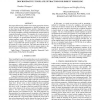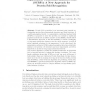68 search results - page 2 / 14 » Discriminative duration modeling for speech recognition with... |
ICASSP
2010
IEEE
13 years 5 months ago
2010
IEEE
This paper addresses the problem of developing appropriate features for use in direct modeling approaches to speech recognition, such as those based on Maximum Entropy models or S...
JCB
2006
13 years 4 months ago
2006
Protein fold recognition is an important step towards understanding protein three-dimensional structures and their functions. A conditional graphical model, i.e., segmentation con...
TASLP
2008
13 years 4 months ago
2008
Abstract--This paper is concerned with the automatic recognition of dialogue acts (DAs) in multiparty conversational speech. We present a joint generative model for DA recognition ...
RECOMB
2005
Springer
14 years 5 months ago
2005
Springer
Abstract. Protein fold recognition is an important step towards understanding protein three-dimensional structures and their functions. A conditional graphical model, i.e. segmenta...
ICASSP
2011
IEEE
12 years 8 months ago
2011
IEEE
Duration of phonemic segments provide important cues for distinguishing words in languages such as Arabic. Recently, we proposed a discriminatively estimated joint acoustic, durat...


